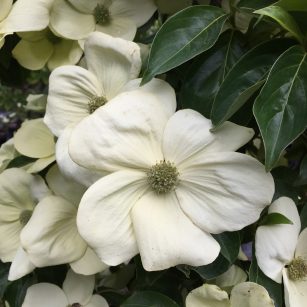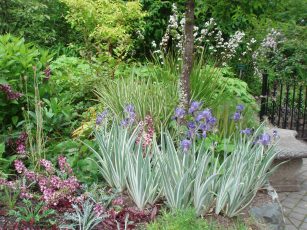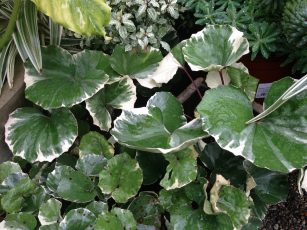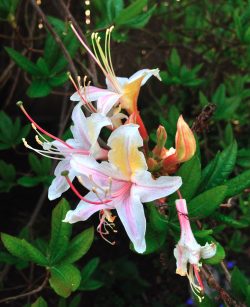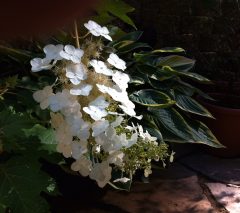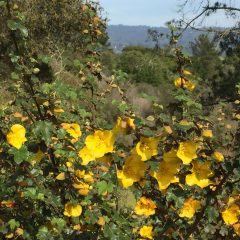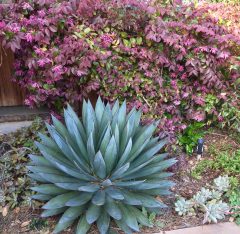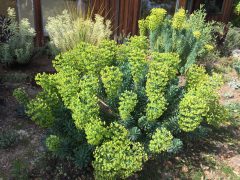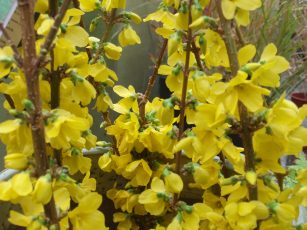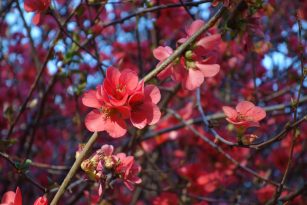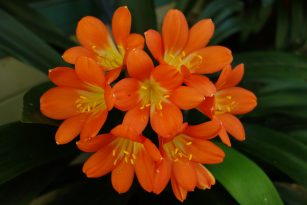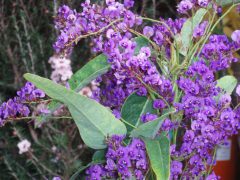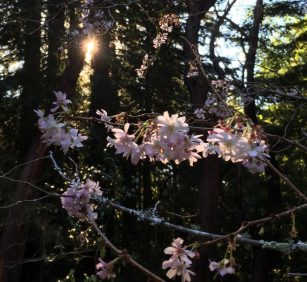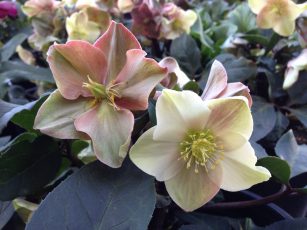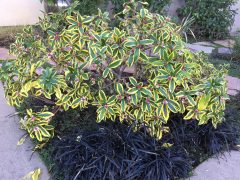
Some years plants bloom a couple weeks earlier than usual but not this year. Our February weather put many plants on hold. Nature?s catching up now. Outside my window the Blireiana flowering plum is covered with dark pink, double blossoms. It’s one of my favorite spring blooming trees with a sweet fragrance strong enough to scent the garden. It usually blooms in February in time for my birthday but not this year. Worth the wait. We all look forward to the earliest flowers of the new season. Spring officially began on March 20th.
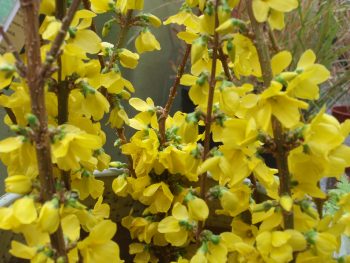
The cold and rainy weather didn?t stop an old fashioned shrub like forsythia from blooming. They figure prominently in many old gardens because they are tough plants, able to survive neglect and still look beautiful. The bare stems of forsythia are completely covered with deep golden-yellow flowers in late winter and early spring and become the focal point of the landscape when in full bloom. The showy stems of this easy care shrub are great for cutting. Forsythias are native to eastern Asia but a chance discovery in Germany by a grower who specialized in breeding for the cut flower industry led to the especially vivid variety ?Kolgold? in the 1800’s. Forsythia has long been used in Chinese medicine. The flower petals contain powerful bacteria-fighting properties which make it an important dressing.
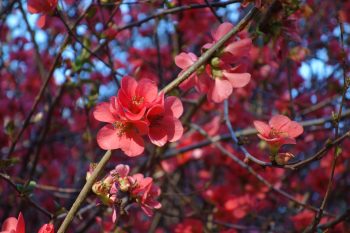
Flowering quince is another old garden staple providing early color. They are easy to care for and nearly indestructible in almost any soil that is well drained and not overly fertile. Once established quince is a very drought tolerant plant and their spiny branches make them an excellent choice for hedges, screening or as a security barrier. There are red, pink, orange and white flowering varieties. The Toyo Nishiki cultivar even has pink, white and solid red flowers all on the same branch.
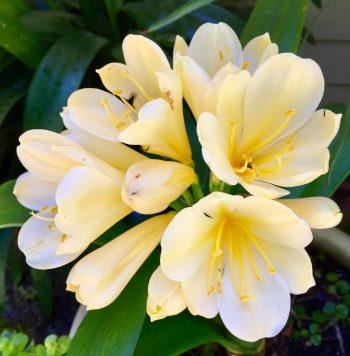
Buds are just starting to form on my clivia or Kaffir Lily. What would a shade garden be without a bright orange clivia? Every year I look forward to their huge flower clusters that emerge from between dark green, strappy leaves. Even in dark shade they will bloom and brighten the late winter/early spring garden although they would do fine in morning sun. If you have a north facing window you can grow them as houseplants. Clivias are hardy to several degrees below freezing. I have a yellow flowering variety also but I?m not seeing any buds forming yet. Possibly it?s too young. Clivie bloom best when crowded.
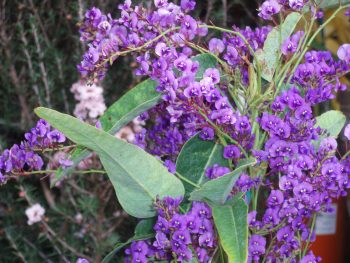
A beautiful vine that blooms at this time of year is hardenbergia ‘Happy Wanderer’. In the pea family, this evergreen vine looks like a small wisteria when in bloom. Pinkish-purple flowers cascade in clusters on twining stems that reach 12-16 feet long. They require little water once established and are hardy to about 23 degrees. If you have an older, tangled plant you can rejuvenate it with hard pruning in early spring after flowering. Never prune in late summer or fall because you will cut off the wood that is going to bloom the following winter.
The last plant I couldn’t live without is Fragrant Sarcococca. The tiny white flowers of this plant are easily overlooked but you can’t miss their scent. I have one near the front door that greets me with that vanilla fragrance every time I walk in or out. The flowers are followed by a bright red fruit. Sweet Box forms a natural espalier against a wall and if you have a problem spot in deep dry shade where other plants won?t grow give this plant a try. They are easy to grow, deer resistant and trouble free.

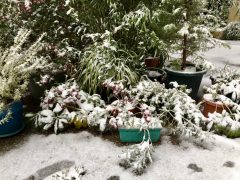
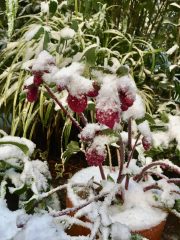 After the snow melted I have to say the hellebore help up perfectly. I received a couple new ones last year for my birthday. Wish I had saved the tags. The double burgundy one is lovely. One of my favorites is called Cinnamon Snow but all of the varieties of this buttercup relative accept wind, rain, cold and less than perfect soil while getting by with only moderate watering in the shady summer garden. Deer aren?t attracted to them either
After the snow melted I have to say the hellebore help up perfectly. I received a couple new ones last year for my birthday. Wish I had saved the tags. The double burgundy one is lovely. One of my favorites is called Cinnamon Snow but all of the varieties of this buttercup relative accept wind, rain, cold and less than perfect soil while getting by with only moderate watering in the shady summer garden. Deer aren?t attracted to them either settle in before setting flowers but beginning last year it?s making up for lost time. There?s something special about a plant that will bloom in the depth of winter, hold up to rain and scent the garden all at the same time. With beautiful rosy-pink flower clusters and attractive yellow-margined variegated foliage, daphne make a great foundation plant for dappled shade gardens. They are deer resistant and have low water requirements during the summer. What?s not to love?
settle in before setting flowers but beginning last year it?s making up for lost time. There?s something special about a plant that will bloom in the depth of winter, hold up to rain and scent the garden all at the same time. With beautiful rosy-pink flower clusters and attractive yellow-margined variegated foliage, daphne make a great foundation plant for dappled shade gardens. They are deer resistant and have low water requirements during the summer. What?s not to love?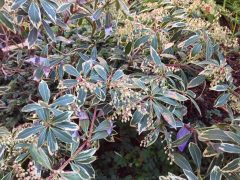 ley shrub (Pieris japonica). There are many varieties of this early winter bloomer. Some have pure white flowers, other sport various shades of pink or dark rose. Mine is the smaller variegated foliage model with dainty, drooping clusters of pure white flowers in early spring. Right now it is covered with flower buds so dense that you?d think it was already blooming. The new growth in the spring has a beautiful pink tint. This shrub will hold up to the wildest weather. Another plus for the Lily-of-the-Valley shrub is that is useful for firescaping in the landscape and it isn?t on the menu for deer either.
ley shrub (Pieris japonica). There are many varieties of this early winter bloomer. Some have pure white flowers, other sport various shades of pink or dark rose. Mine is the smaller variegated foliage model with dainty, drooping clusters of pure white flowers in early spring. Right now it is covered with flower buds so dense that you?d think it was already blooming. The new growth in the spring has a beautiful pink tint. This shrub will hold up to the wildest weather. Another plus for the Lily-of-the-Valley shrub is that is useful for firescaping in the landscape and it isn?t on the menu for deer either.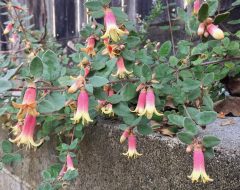 variegated variety called Correa ?Wyn?s Wonder? to my own garden a couple years ago but I was cavalier about protecting it from gophers and alas it is not with me anymore. Still it?s a great plant. Although not related to hybrid fuchsias, the flowers are similar and their nectar feed the Anna?s hummingbirds when there?s not a lot of plants blooming for them. Australian fuchsia grow well in dry shade under oaks are deer resistant and drought tolerant.
variegated variety called Correa ?Wyn?s Wonder? to my own garden a couple years ago but I was cavalier about protecting it from gophers and alas it is not with me anymore. Still it?s a great plant. Although not related to hybrid fuchsias, the flowers are similar and their nectar feed the Anna?s hummingbirds when there?s not a lot of plants blooming for them. Australian fuchsia grow well in dry shade under oaks are deer resistant and drought tolerant.